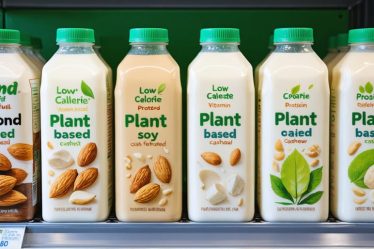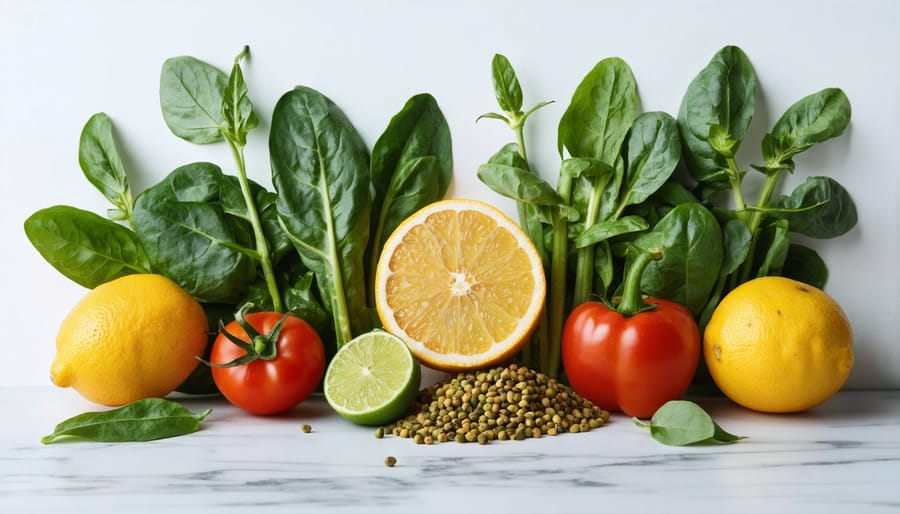
Transform your relationship with iron-rich foods by mastering the art of optimal absorption. Pair your leafy greens and legumes with vitamin C-rich foods like bell peppers or citrus fruits to boost iron absorption by up to 300%. While morning coffee and tea bring comfort, enjoy them between meals rather than with iron-rich foods, as their tannins can decrease iron absorption significantly. Your body craves iron in its most bioavailable form, which comes from thoughtfully combining plant-based iron sources with absorption enhancers.
Think of iron absorption as a delicate dance between nutrients – some partners enhance the performance, while others may step on toes. By understanding these relationships, you can orchestrate meals that maximize your body’s iron uptake, especially crucial for women, athletes, and plant-based eaters. Whether you’re dealing with low iron levels or simply wanting to optimize your nutrition, small adjustments to your eating habits can make a remarkable difference in how your body receives this essential mineral.
Why Your Body Might Not Be Getting Enough Iron
The Difference Between Plant and Animal Iron
You know how some foods just seem to give you more energy than others? That’s partly because not all iron is created equal! Let me break it down for you in a way that’ll make your next grocery trip so much more purposeful.
Iron comes in two forms: heme iron (found in animal products) and non-heme iron (found in plant foods). Think of heme iron as the VIP guest at the party – it gets straight through the door with minimal fuss, with your body absorbing about 15-35% of it. This is the type you’ll find in meat, fish, and poultry.
Non-heme iron, on the other hand, is like having a more complicated entrance process. Your body only absorbs about 2-20% of it, and it needs a little help from other nutrients to get through. I learned this the hard way when I switched to a plant-based diet – my energy levels dipped until I figured out how to combine my iron-rich foods properly!
The good news? Once you understand these differences, you can make smarter food choices to maximize your iron intake, regardless of your dietary preferences.
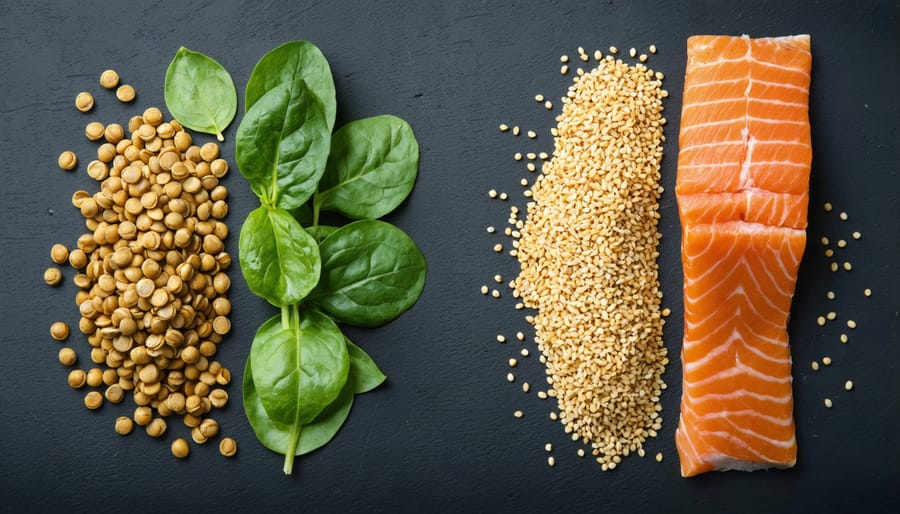
Kitchen Magic: Food Combinations That Boost Iron Absorption
Vitamin C Heroes
When it comes to making the most of your iron-rich meals, think of vitamin C as your secret weapon! These nutritional powerhouses can boost iron absorption by up to three times when paired strategically with your iron sources.
Fresh citrus fruits like oranges, grapefruits, and lemons are excellent companions to your iron-rich meals. But don’t stop there! Bell peppers, especially the vibrant red ones, pack a serious vitamin C punch. I love adding sliced strawberries to my spinach salad or tossing some cherry tomatoes into my lentil dishes – both delicious ways to enhance iron absorption.
Some surprising vitamin C heroes include broccoli, Brussels sprouts, and kiwi fruit. Even potatoes, particularly when fresh and properly cooked, can contribute meaningful amounts of vitamin C to your meals. My personal favorite combo is adding a squeeze of lemon to sautéed dark leafy greens – it’s simple, tasty, and effectively boosts iron absorption while adding a bright pop of flavor!
Remember, these vitamin C-rich foods work best when eaten during the same meal as your iron sources, so plan your pairings accordingly.
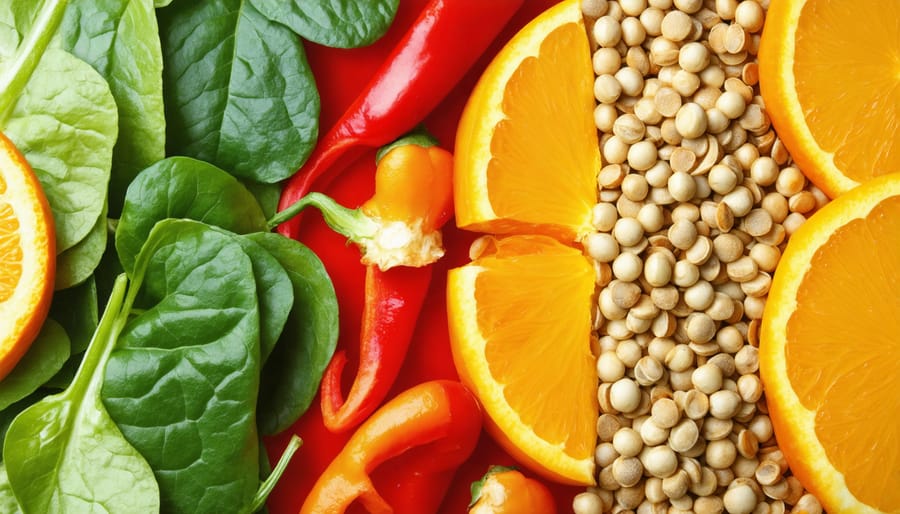
Perfect Timing
Timing really is everything when it comes to maximizing your iron absorption! As someone who struggled with low iron levels for years, I’ve learned that when you eat certain foods can make a huge difference. The golden rule? Have your iron-rich foods with vitamin C-rich ingredients during your main meals, but keep your coffee and tea for between-meal breaks.
Here’s a simple daily schedule I follow: I start my morning with an iron-fortified breakfast along with some fresh orange segments or berries. Then, I wait about an hour before having my morning coffee. For lunch and dinner, I pair iron-rich foods with vitamin C sources, like adding bell peppers to my lentil curry or squeezing lemon over my spinach salad.
Try to avoid calcium-rich foods during your iron-heavy meals – save that Greek yogurt or cheese for your snacks instead. And if you’re taking iron supplements, your healthcare provider might recommend taking them on an empty stomach or at bedtime for optimal absorption. Remember, these small timing adjustments can significantly boost your body’s ability to absorb iron!
What’s Blocking Your Iron Absorption?
Ever had those moments when you’re doing everything right with your iron-rich foods but still feeling low on energy? The culprit might be hiding in your daily habits! While I used to mindlessly sip my coffee with meals, I’ve learned that certain everyday favorites can actually block iron absorption.
Your morning cup of coffee or tea contains compounds called tannins that can significantly reduce iron absorption. The same goes for that glass of red wine you enjoy with dinner. Even calcium-rich foods like dairy products, while fantastic for bone health, can temporarily interfere with iron uptake.
Here’s what to watch out for:
– Coffee and tea (especially black and green varieties)
– Dairy products (milk, cheese, yogurt)
– Red wine
– Whole grain cereals (due to phytates)
– Legumes (also contain phytates)
But don’t worry – you don’t need to give up these foods! The key is timing. Try spacing them out from your iron-rich meals by about two hours. For instance, enjoy your morning coffee, wait a bit, then have your iron-fortified breakfast. Or save that yogurt parfait for an afternoon snack instead of having it alongside your spinach salad at lunch.
Remember, it’s all about creating a balanced routine that works for your lifestyle while maximizing your nutrient absorption. Small tweaks in timing can make a big difference in how well your body uses the iron you’re consuming.
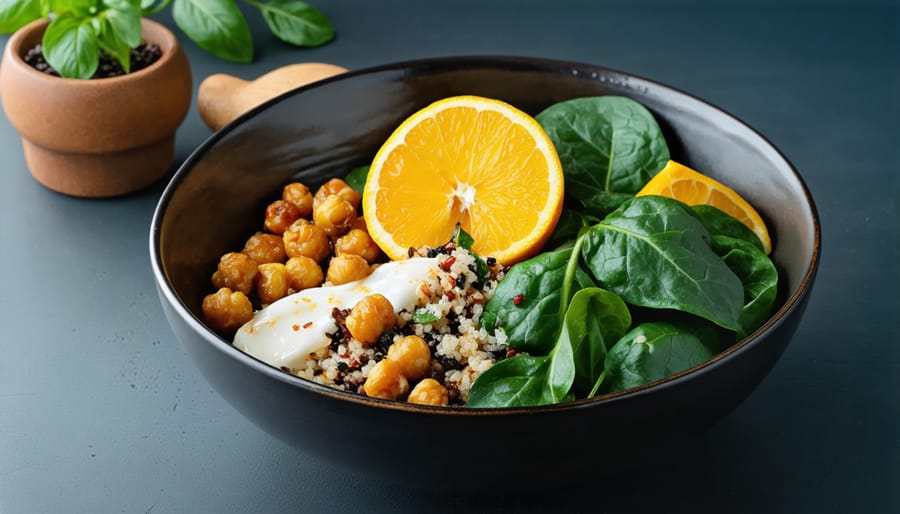
Easy Recipe Ideas for Maximum Iron Absorption
Ready to supercharge your iron absorption? Let’s dive into some delicious recipes that pair iron-rich ingredients with absorption boosters. Here’s my go-to power breakfast: blend spinach, strawberries, and orange segments for a vitamin C-packed smoothie that helps your body absorb iron more effectively. For lunch, try my Mediterranean quinoa bowl – combine cooked quinoa with lentils, roasted bell peppers, and a squeeze of lemon juice.
One of my favorite weeknight dinners is a stir-fry that maximizes iron absorption: sauté dark leafy greens with sliced bell peppers, add tofu or tempeh, and finish with a citrus-ginger sauce. The vitamin C from the peppers helps unlock the iron from the greens, making these plant-based meals nutritional powerhouses.
For a quick snack, try pairing pumpkin seeds with orange segments, or spread hummus on whole-grain crackers and top with sliced tomatoes. These combos aren’t just delicious – they’re strategically paired to help your body absorb more iron. End your day with an iron-rich dessert by mixing dark chocolate chunks into vitamin C-rich berries, proving that healthy eating can definitely satisfy your sweet tooth!
Remember to avoid drinking tea or coffee with these meals, as they can interfere with iron absorption. Instead, enjoy your hot beverages between meals for the best results.
Getting the most iron from your food doesn’t have to be complicated! By implementing these simple strategies – like pairing iron-rich foods with vitamin C sources, being mindful of timing your tea and coffee consumption, and incorporating a variety of iron-rich foods into your meals – you can significantly improve your body’s iron absorption. Remember, small changes can make a big difference in your overall health and energy levels. I’ve seen countless women in our community transform their well-being by making these adjustments to their daily routines. Start with one or two changes that feel most manageable to you, and gradually incorporate more as they become habits. Your body will thank you for taking these positive steps toward better iron absorption. Here’s to energized, vibrant days ahead!

